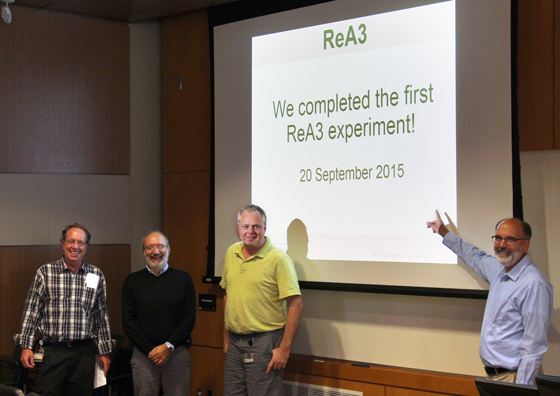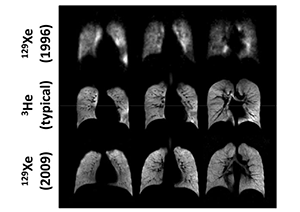Archives
November 2015
First ReA3 Experiment
The NSCL passed another significant milestone when the entire NSCL facility operated in concert to make one experiment possible. The first scheduled experiment with a rare-isotope beam produced by the coupled cyclotrons, separated with the A1900, thermalized in N4, charge-bred in the EBIT and then reaccelerated by ReA3 was used to carry out an experiment with the AT-TPC.
The experiment aimed to study how 46Ar is changed by the addition of another neutron. The changes that occurred in the structure of nuclei as neutrons and protons are added provide important input into testing and refining nuclear models. This information is particularly interesting because of mysteries surrounding the character of 46Ar and its neighbors on the nuclear chart. It is the first in a series of similar experiments that offer the opportunity to explore the nuclear landscape with as few as a few hundred atoms per second.

Laboratory leaders were pleased to share the excitement of this milestone experiment with the entire lab.
August 2015
The A1900 Fragment SeparatorWe are coming up on the 14th birthday of the A1900 fragment separator. This device was constructed as part of the coupled-cyclotron upgrade of the NSCL and began operating in the summer of 2001. The A1900 is used to collect rare isotopes that are produced by the interaction of the primary (stable isotope) beam with a beryllium metal target and then select out one or more rare isotopes that the experimenters want to study from the hundreds that are produced. The A1900 is thirty-five meters (~115 ft) long and uses four large dipole (bending) magnets, 24 large quadrupole (focusing) magnets, and 18 correction magnets. The tremendous range of isotopes that have been separated out and delivered to experimenters is shown in the accompanying figure that is often seen around the lab. Essentially all of the nuclei that can exist in the lower region of the chart have been produced and separated, there are no others. The scientific success of the laboratory was due in part to its innovative design and continues to rely on its successful operation.

And what about that name? The name “A1900” follows a tradition at the NSCL that originally comes from the naming of cyclotrons according to their power. Proton beams from all cyclotrons have a maximum theoretical energy that is called their K-number. The first machine at MSU was the K50 cyclotron that could produce 50 MeV (million electron volts of energy) beams. Then came the K500 and K800 cyclotrons and about the same time a spectrometer was designed to measure the reaction products called the S800. The K800 cyclotron was renamed to K1200 as this number was thought to be a better representation of the theoretical power of the machine. The first device specifically built to analyze or separate out the reaction products at the NSCL was called the A1200. The name of the A1900 indicates that it is more powerful at bending and separating out reaction products than the cyclotron that produces the primary beams. This higher power is necessary to collect the neutron-rich products that the experimenters want to study. The A1900 will be reconfigured and become part of the new fragment separator being built as part of FRIB.
Watch this video, where NSCL physicist Tom Ginter explains how the A1900 Fragment Separator picks out the few nuclei wanted for experiments.
July 2015
Zach Constan Honored With The Jack Breslin Distinguished Staff Award
Our NSCL Outreach Coordinator, Zach Constan, was awarded The Jack Breslin Distinguished Staff Award on June 1. The award is presented annually to six University staff members, who are individually nominated by their supervisors and colleagues. The award is named in honor of the late Jack Breslin, a student leader, honored athlete, former University Vice President, and steadfast advocate of MSU.
Zach was given the award for his outstanding efforts in outreach, such as his presentations in classrooms and tours of the Laboratory. If you have ever been on a tour, you are well aware of Zach’s skill at making it easy and interesting to understand the research performed at NSCL. Zach’s ability to communicate enthusiastically to people of all ages, and with diverse backgrounds is exceptional. He serves as a true ambassador for the laboratory and MSU.
Since 2006, Zach has given more than 1,000 tours of NSCL/FRIB to groups as diverse as elementary school students to donors to congressional staffers, totaling more than 25,000 visitors.
If you have not toured NSCL recently, click here to sign up for a tour. Community and school groups are welcome, as is anyone interested in learning more about nuclear science!

|
Pictured (from left): MSU Assistant Vice President for Human Resources Sharon Butler, MSU Executive Vice President for Administrative Services Satish Udpa, Zach Constan, and MSU President Lou Anna K. Simon. Photo by Derrick L. Turner, MSU Communications and Brand Strategy |
July 2015
Searching for Lung Disease and the Origin of Matter Using Magnetized Noble Gases
Magnetic resonance imaging (MRI) is a noninvasive medical test that helps physicians diagnose and treat medical conditions. MRI uses a powerful magnetic field, radio frequency pulses and a computer to produce detailed pictures of organs, soft tissues, bone and virtually all other internal body structures. Jaideep Taggart Singh’s research group is currently building a device that will produce magnetized gas for use in imaging experiments using MRI technology.
One of the long term goals of his group at NSCL is to make this technique available to MRI groups at Michigan State and the surrounding area. Their technique involves polarizing nuclei in noble gases. One such noble gas, Xe, is used in lung scans. A patient inhales polarized Xe-129 before having an MRI. This gas produces much clearer images used in diagnosing lung problems such as COPD and asthma. Problems areas in the lungs are clearly visible. Both He-3 and Xe-129 have been used for lung images using MRI, see image below. Xe has shown advantages over He in the visibility on MRI images, as shown in the figure below.

Figure: Mugler & Altes, Jour. MRI 37:313-331 (2013).
Singh’s research has focused on laser techniques used to polarize (align) the nuclei of He-3 atoms. Their technique has improved on this by nearly a factor of 10. As a result, they have doubled the polarization (degree of the nuclear alignment) of twice as many He-3 atoms in half the time compared to previous techniques. The polarization is first transferred from laser light to vaporized metal atoms. These metal atoms then collide with the He-3 atoms transferring their polarization. They have shown how to (1) properly match the color of the laser light to the vaporized metal atoms and (2) mix two different types of metals to improve the polarization transfer to the He-3 atoms. Liters of polarized He-3 gas can now be simply produced in hours with much greater consistency than before.
The group’s primary motivation for developing these new techniques is to prepare He-3 targets used for electron scattering experiments that seek to image the internal structure of neutrons. These new techniques also benefit MRI (magnetic resonance imaging) experiments that use He-3 or Xe-129 gas for studying the structure and function of lungs. The improvements described in the paper allow the MRI community to produce higher quality lung images and to perform more experiments.
You can read the full study in Physical Review C
DOI: http://dx.doi.org/10.1103/PhysRevC.91.055205
June 2015
NSCL Discovery Constrains r-Process
The astrophysical r-process is responsible for the synthesis of about half of the isotopes of the heavy elements. There are several open questions associated with this important process, the most significant of which is unambiguously determining the astrophysical site. In order to improve our understanding of the r-process we need to reduce the uncertainties associated with the nuclear physics input in r-process calculations. This is the focus of many NSCL experiments that provide information such as the mass, β-decay half-life and β-delayed neutron emission probability for key nuclei.
An important missing piece is the measurement of neutron-capture reactions on short-lived nuclei. These reactions are a major part of the r-process reaction flow and can directly affect the final abundance distributions. However, these short-lived nuclei are not accessible in the lab for direct measurements and therefore indirect approaches are used to provide constraints.
In a recent collaboration between NSCL and Oslo University, a new approach for studying (n,γ) reactions was proposed, tested, and published in Physical Review Letters. In the so-called “β-Oslo” technique, a total absorption spectrometer, like the SuN detector at the NSCL, can be used for measuring basic nuclear properties of heavy nuclei, namely the nuclear level density and the γ-ray strength function. Using these experimental quantities the uncertainties in the neutron-capture reactions can be reduced from a factor of 100 to approximately 2-3. This is a significant improvement of our understanding of these reactions and is therefore expected to have a major impact on r-process modeling.
The publication describes the first application of the β-Oslo technique for the nucleus 76Ge populated through the β-decay of 76Ga. With this measurement we were able to extract the cross section of the neutron capture on the nucleus 75Ge, a reaction that cannot be measured directly since 75Ge has a half-life of only 83 minutes.
You can read the full study in Physical Review Letters
DOI: http://dx.doi.org/10.1103/PhysRevLett.113.232502
May 2015
Mass Measurements Pinpoint Magic Number DisappearanceNuclei are known to display so-called “magic” numbers of protons or neutrons, for which a nucleus is especially stable against nuclear decay compared to nuclei with slightly different numbers of protons and neutrons. What these magic numbers of protons and neutrons are is well known for stable nuclei – they are 2, 8, 20, 28, 50, 82, and 126 – but experiments with rare isotopes have revealed that they can change for more exotic proton-deficient (neutron-rich) and proton-rich (neutron-deficient) nuclei. An open question was how proton-deficient a nucleus with 28 neutrons has to be for the neutron magic number 28 to disappear. Knowing the answer enables theorists to precisely characterize the forces that hold nuclei together.
A recent experiment conducted at the NSCL now determined the number of protons that makes the neutron magic number 28 disappear by demonstrating that Argon-46, with 18 protons and 28 neutrons, is indeed still magic. With previous experiments showing that Sulfur-44, with 16 protons and 28 neutrons, is not neutron magic, this clearly demonstrates that disappearance of the magic quality for nuclei with 28 neutrons occurs when the nucleus has fewer than 18 protons.
This result was possible by determining the masses of Argon-48 and Argon-49 with an incredible precision of 1 part in 100,000. This precision would allow you to notice the difference in a person’s weight before and after eating a tic-tac! This was a particular challenge given that Argon-48 and Argon-49 are rare isotopes that only exist for ½ and 1/5 of a second, respectively. The Argon isotopes were produced by shattering stable Selenium isotopes accelerated to a velocity of half the speed of light at the Coupled Cyclotron Facility at NSCL on a Beryllium target. The high-velocity Argon isotopes which were produced in the collisions traversed a 200 foot flight-path into a spectrometer within half a microsecond. A precision measurement of their flight times allowed the researchers to calculate the mass of each nucleus. The mass differences were then used to establish neutron magic quality of Argon-46.
You can read the full study in Physical Review Letters
DOI: http://dx.doi.org/10.1103/PhysRevLett.114.022501
January 2015
First Beam acceleration through cryomodule 3 marks completion of the ReA3 project
November 2014 marked an important milestone for NSCL. The first ion beam was accelerated through cryomodule 3 by the ReA operations team. A H2+ beam from the pilot ion source was accelerated through the room temperature RFQ to 600keV/u, then matched into the superconducting linac and transported to the beam distribution line in the ReA6 vault. This acceleration marks the completion the ReA3 project.
ReA3 consists of three cryomodules containing a total of 15 superconducting quarterwave cavities. Two cavity types are used in this part of the linac. The first two cryomodules are optimized for a beta of 0.041 (or a particle velocity of 4.1% of the speed of light), the recently installed cryomodule 3 transitions the linac to higher velocity beams and is optimized for a beta of 0.085 (or a particle velocity of 8.5% of the speed of light). The completed accelerator is designed to accelerate ions with a charge to mass ratio from 0.5 to 0.2 and will be able to accelerate heavy ion from hydrogen to uranium to a maximum energy of 3 MeV/nucleon for the heaviest ions and up to 6 MeV/u for lighter ions. By using the lowest beta cavities to decelerate the beam after the RFQ, it is also possible to reach a minimum energy of 300keV/u for all ions. Since all cavities can be individually phased the energy can be adjusted in a few keV steps within its energy range to measure excitation functions; e.g. scan through resonances in small energy steps.
The fully upgraded ReAccelerator (ReA12) will include a high energy linac section with three additional beta=0.085 cryomodules and rebunching modules for a total of 42 individually phased superconducting quarter wave cavities..
In addition to the installation of cryomodule 3 the last shutdown was also utilized to reconfigure the Low Energy Beam Transport (LEBT) line to allow for better matching of the low energy beam into the RFQ. This relocation will enable the future installation of a low frequency pre-buncher for the ReAccelerator which will provide the option to use a beam bunch spacing of 62.5 nsec instead the 12.5 nsec bunch spacing given by the 80.5MHz RF frequency.
Recommissioning of the EBIT magnet is expected to begin soon, with first rare isotope experiments starting in summer of 2015 in the ReA3 low energy hall.
December 2014
The book Blazing the Trail: Essays by Leading Women in Science contains a collection of essays from 35 prominent women in science who tell the stories of their careers. The fascinating essays provide detailed insight in their very diverse paths to success and the authors reflect on their experiences, positive and negative. In the process they give great advice and encouragement to young (female) researchers. The book is a great read and highly recommended for everyone interested in science and scientists’ careers. It is so easy to be inspired by the women scientists who contributed to the book and their career stories.
Blazing the Trail: Essays by Leading Women in Science was co-authored by Emma Ideal (graduate student at Yale) and Rhiannon Meharchand, who graduated with a Ph.D. from NSCL in 2011. Rhiannon’s motivation for working on this project in her own words: “I hope this book provides real-life role models for young women everywhere, and inspires them to dream big, work hard and achieve things they never thought possible.”
The book can be purchased for less than $10 and any profits are used for purchasing more copies for distribution to high-schools and undergraduate programs. Financial support for the publication of the book was provided by the Yale University Physics Department and NSCL.



